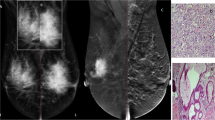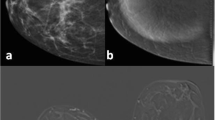Abstract
Objectives
To investigate the inclusion of breast MRI in radiological assessment of suspicious, isolated microcalcifications detected with mammography.
Methods
In this prospective, multicenter study, cases with isolated microcalcifications in screening mammography were examined with dynamic contrast-enhanced MRI (DCE-MRI) before biopsy, and contrast enhancement of the relevant calcification localization was accepted as a positive finding on MRI. Six experienced breast radiologists evaluated the images and performed the biopsies. Imaging findings and histopathological results were recorded. Sensitivity, specificity, NPV, and PPV of breast MRI were calculated and compared with histopathological findings.
Results
Suspicious microcalcifications, which were detected by screening mammograms of 444 women, were evaluated. Of these, 276 (62.2%) were diagnosed as benign and 168 (37.8%) as malignant. Contrast enhancement was present in microcalcification localization in 325 (73.2%) of the cases. DCE-MRI was positive in all 102 invasive carcinomas and in 58 (87.9%) of 66 DCIS cases. MRI resulted in false negatives in eight DCIS cases; one was high grade and the other seven were low-to-medium grade. The false-negative rate of DCE-MRI was 4.76%. The sensitivity, specificity, PPV, and NPV for DCE-MRI for mammography-detected suspicious microcalcifications were 95.2%, 40.2%, 49.2%, and 93.3%, respectively.
Conclusions
In this study, all invasive cancers and all DCIS except eight cases (12.1%) were detected with DCE-MRI. DCE-MRI can be used in the decision-making algorithm to decrease the number of biopsies in mammography-detected suspicious calcifications, with a tradeoff for overlooking a small number of DCIS cases that are of low-to-medium grade.
Key Points
• All invasive cancer cases and 87.8% of all in situ cancer cases were detected with MRI, showing a low false-negative rate of 4.7%.
• Dynamic contrast-enhanced MRI can be used in the decision-making algorithm to decrease the number of biopsies in mammography-detected suspicious calcifications, with a tradeoff for overlooking a small number of DCIS cases that are predominantly low-to-medium grade.
• If a decision for biopsy were made based on MRI findings in mammography-detected microcalcifications in this study, biopsy would not be performed to 119 cases (26.8%).


Similar content being viewed by others
Abbreviations
- BIRADS:
-
Breast Imaging and Reporting System
- BPE:
-
Background parenchymal enhancement
- DCE-MRI:
-
Dynamic contrast-enhanced MRI
- DCIS:
-
Ductal carcinoma in situ
- FN:
-
False negative
- MRI:
-
Magnetic resonance imaging
- NME:
-
Non-mass enhancement
- NPV:
-
Negative predictive value
- PPV:
-
Positive predictive value
- TP:
-
True positive
References
Bluekens AMJ, Holland R, Karssemeijer N, Broeders MJM, den Heeten GJ (2012) Comparison of digital screening mammography and screen film mammography in the early detection of clinically relevant cancers: a multicenter study. Radiology 265:707–714
D’Orsi CJ, Sickles EA, Mendelson EB et al (2013) ACR BI-RADS Atlas, breast imaging reporting and data system. American College of Radiology, Reston
Kettritz U, Rotter K, Schreer I et al (2004) Stereotactic vacuum assisted breast biopsy in 2874 patients: a multicenter study. Cancer 100:245–251
Liberman L, Abramson AF, Squires FB, Glassman JR, Morris EA, Dershaw DD (1998) The breast imaging reporting and data system: positive predictive value of mammographic features and final assessment categories. AJR Am J Roentgenol 171:35–40
Rominger M, Wisgickl C, Timmesfeld N (2012) Breast microcalcifications as type descriptors to stratify risk of malignancy: a systematic review and meta-analysis of 10665 cases with special focus on round/punctate microcalcifications. Rofo 184:1144–1152
Kuhl CK, Schrading S, Bieling HB et al (2007) MRI for diagnosis of pure ductal carcinoma in situ: a prospective observational study. Lancet 370:485–492
Houssami N, Ciatto S, Macaskill P et al (2008) Accuracy and surgical impact of magnetic resonance imaging in breast cancer staging: systematic review and meta-analysis in detection of multifocal and multicentric cancer. J Clin Oncol 26:3248–3258
Bennani-Baiti B, Baltzer PAT (2017) MR imaging for diagnosis of malignancy in mammographic microcalcifications: a systematic review and meta-analysis. Radiology 283:692–701
Kikuchi M, Tanino H, Kosaka Y et al (2014) Usefulness of MRI of microcalcification lesions to determine the indication for stereotactic mammotome biopsy. Anticancer Res 34:6749–6753
Dorrius MD, Pijnappel RM, Jansen-van der Weide MC, Oudkerk M (2010) Breast magnetic resonance imaging as a problem-solving modality in mammographic BI-RADS 3 lesions. Cancer Imaging 10:S54–S58
Strobel K, Schrading S, Hansen NL, Barabasch A, Kuhl CK (2015) Assessment of BI-RADS category 4 lesions detected with screening mammography and screening US: utility of MR imaging. Radiology 274:343–351
Baltzer PAT, Bennani-Baiti B, Stöttinger A, Bumberger A, Kapetas P, Clauser P (2018) Is breast MRI a helpful additional diagnostic test in suspicious mammographic microcalcifications? Magn Reson Imaging 46:70–74
Bennani-Baiti B, Dietzel M, Baltzer PA (2017) MRI for the assessment of malignancy in BIRADS 4 mammographic microcalcifications. PLoS One 12(11):e0188679. https://doi.org/10.1371/journal.pone.0188679
Hrkac-Pustahija A, Ivanac G, Brkljacic B (2018) Ultrasound and MRI in the evaluation of mammographic BI-RADS 4 and 5 microcalcifications. Diagn Interv Radiol 24:187–194
Bazzocchi M, Zuiani C, Panizza P et al (2006) Contrast-enhanced breast MRI in patients with suspicious microcalcifications on mammography: results of a multicenter trial. AJR Am J Roentgenol 186:1723–1732
Linda A, Zuiani C, Londero V et al (2014) Role of magnetic resonance imaging in probably benign (BI-RADS category 3) microcalcifications of the breast. Radiol Med 119:393–399
Brnic D, Brnic D, Simundic I, Vanjaka Rogosic L, Tadic T (2016) MRI and comparison mammography: a worthy diagnostic alliance for breast microcalcifications? Acta Radiol 57:413–421
Li E, Li J, Song Y, Xue M, Zhou C (2014) A comparative study of the diagnostic value of contrast-enhanced breast MR imaging and mammography on patients with BI-RADS 3–5 microcalcifications. PLoS One 9(11):e111217. https://doi.org/10.1371/journalpone.0111217
Uematsu T, Yuen S, Kasami M, Uchida Y (2007) Dynamic contrast-enhanced MR imaging in screening detected microcalcification lesions of the breast: is there any value? Breast Cancer Res Treat 103:269–281
Shimauchi A, Machida Y, Meada I, Fukuma E, Hoshi K, Tozaki M (2018) Breast MRI as a problem-solving study in the evaluation of BI-RADS categories 3 and 4 microcalcifications: is it worth performing? Acad Radiol 25:288–296
Badan GM, Piato S, Junior DR, Fleury EFC (2016) Predictive values of BI-RADS magnetic resonance imaging (MRI) in the detection of breast ductal carcinoma in situ (DCIS). Eur J Radiol 85:1701–1707
Stehouwer BL, Merckel LG, Verkooijen HM et al (2014) 3-T breast magnetic resonance imaging in patients with suspicious microcalcifications on mammography. Eur Radiol 24:603–609
Kneeshaw PJ, Lowry M, Manton D, Hubbard A, Drew PJ, Turnbull LW (2006) Differentiation of benign from malignant breast disease associated with screening detected microcalcifications using dynamic contrast enhanced magnetic resonance imaging. Breast 15:29–38
Zhu J, Kurihara Y, Kanemaki Y et al (2007) Diagnostic accuracy of high-resolution MRI using a microscopy coil for patients with presumed DCIS following mammography screening. J Magn Reson Imaging 25:96–103
Giess CS, Chikarmane SA, Sippo DA, Birdwell RL (2017) Clinical utility of breast MRI in the diagnosis of malignancy after inconclusive or equivocal mammographic diagnostic evaluation. AJR Am J Roentgenol 208:1378–1385
Holland R, Hendriks JH, Vebeek AL, Mravunac M, Stekhoven SJH (1990) Extent, distribution, and mammographic/histological correlations of breast ductal carcinoma in situ. Lancet 335:519–522
Bluemke DA, Gatsonis CA, Chen MH et al (2004) Magnetic resonance imaging of the breast prior to biopsy. JAMA 292:2735–2742
Acknowledgments
Dr. Fusun Taskin, Dr. Erkin Aribal, and Dr. Nermin Tuncbilek provided and controlled the statistical analysis of this manuscript.
Funding
The authors state that this work has not received any funding.
Author information
Authors and Affiliations
Corresponding author
Ethics declarations
Guarantor
The scientific guarantor of this publication is Prof. Dr. Erkin Aribal.
Conflict of interest
The authors of this manuscript declare no relationships with any companies whose products or services may be related to the subject matter of the article.
Statistics and biometry
No complex statistical methods were necessary for this paper.
Informed consent
Written informed consent was obtained from all subjects (patients) in this study.
Ethical approval
Institutional Review Board approval was obtained.
Methodology
• Prospective
• Multicenter study
Additional information
Publisher’s note
Springer Nature remains neutral with regard to jurisdictional claims in published maps and institutional affiliations.
Rights and permissions
About this article
Cite this article
Taskin, F., Kalayci, C.B., Tuncbilek, N. et al. The value of MRI contrast enhancement in biopsy decision of suspicious mammographic microcalcifications: a prospective multicenter study. Eur Radiol 31, 1718–1726 (2021). https://doi.org/10.1007/s00330-020-07265-y
Received:
Revised:
Accepted:
Published:
Issue Date:
DOI: https://doi.org/10.1007/s00330-020-07265-y




